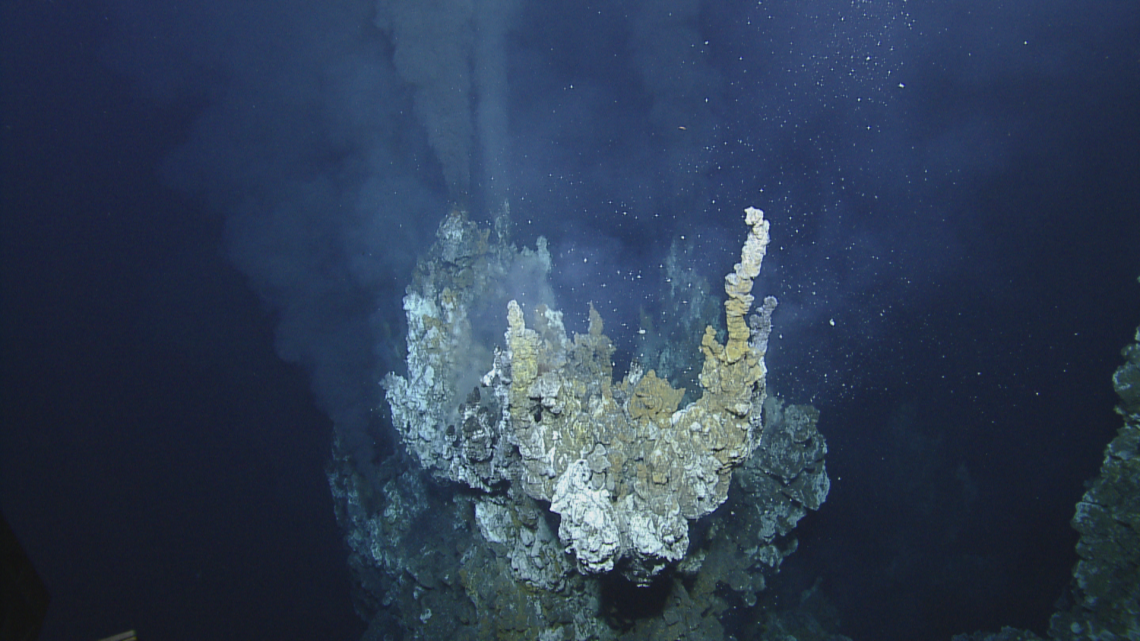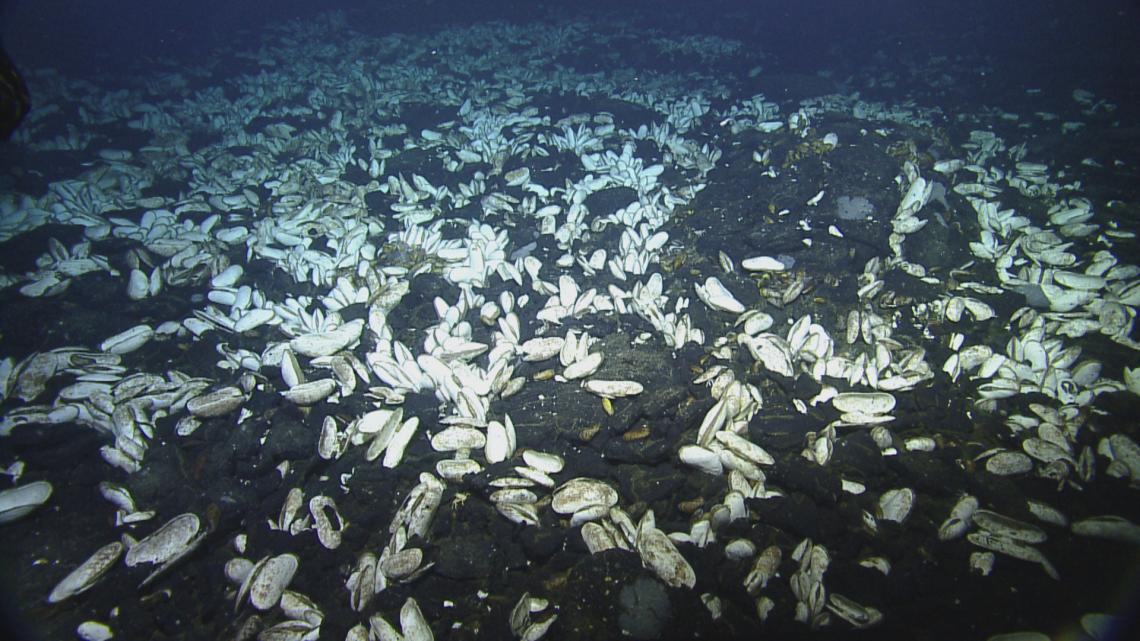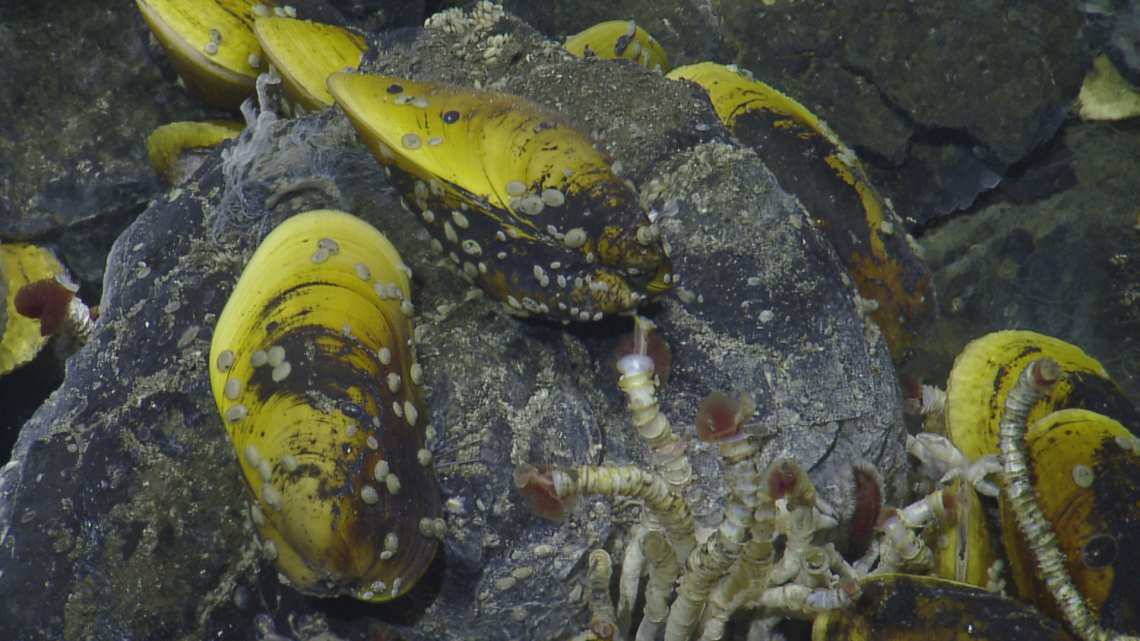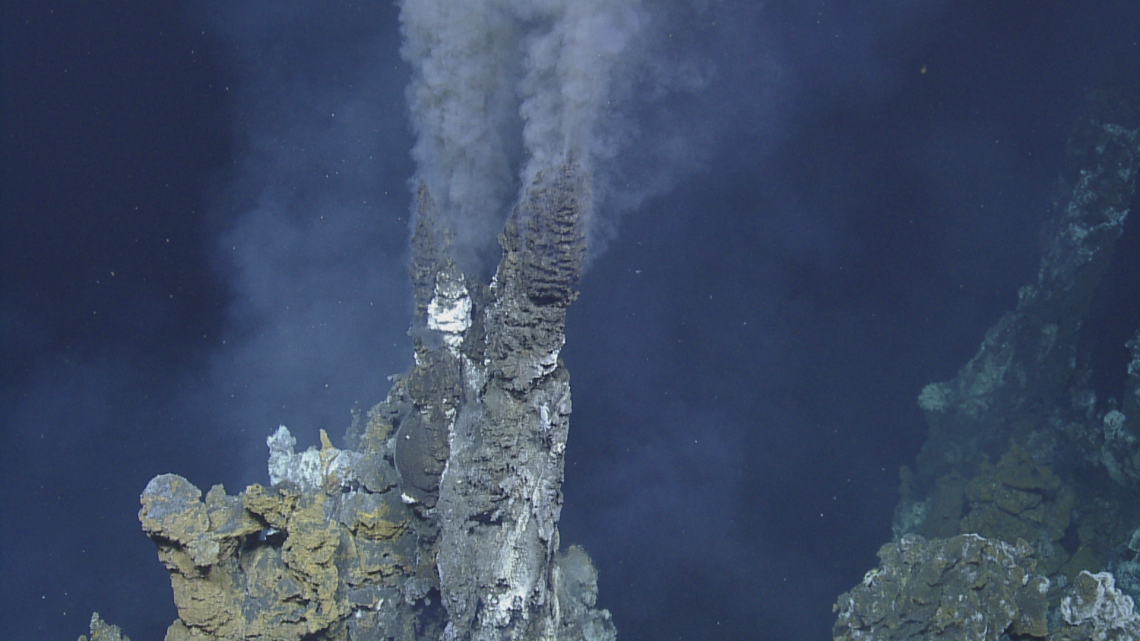Traducción al español a continuación
Deep-sea hot springs, also known as hydrothermal vents, were discovered in 1977 along the Eastern Galápagos Spreading Center (EGSC), about 250 miles from the Galápagos Islands. Since then, these hydrothermal areas, as well as those elsewhere around the world, have been visited periodically by researchers eager to study the biology, chemistry, and geology of these unique seafloor ecosystems. This research has enabled significant advances in our knowledge of the limits of life, Earth’s internal geological processes, and the chemistry of our oceans. Today, an interdisciplinary team, composed of researchers from six institutions and in collaboration with the Charles Darwin Foundation, the Galápagos National Park, and local navy INOCAR, sails west of the Galapagos Islands to find, investigate, and characterize the underexplored and unknown vents of this area. Here, we plan to explore three known areas of hydrothermal venting, called Iguanas, Pingüinos, and Navidad, and to locate and explore two additional areas, which are suspected based on the detection of a chemical signature that is unique to vents in the water above.

Hydrothermal vents are created when seawater seeps into the ocean’s crust, becomes superheated by geothermal heat, chemically transformed by rock interaction, and emerges from the seafloor as underwater geysers. The emerging fluid is enriched in natural chemicals like hydrogen sulfide, hydrogen, methane, and metals like iron, providing a gas- and metal-rich soup that supports abundant animal and microbial life. Hydrothermal vents represent some of the most biologically productive habitats in the world’s Ocean, even though sunlight for photosynthesis does not reach the deep ocean. Instead, the base of the food chain is made of microbes that can grow using the chemical energy in the venting fluid through a metabolic process called chemosynthesis. The predominant animals (like clams, mussels, and giant tubeworms) form symbiotic relationships with chemosynthetic bacteria that live in and on their tissues, which they depend on for nourishment. Reliance on their symbionts means that the animals no longer consume food for primary nutrition, an advantage in the food-limited deep ocean. This relationship also directly links the geological processes creating the hot springs, their unique chemistry, and the biology inhabiting them.

Previous expeditions to Iguanas, Pingüinos, and Navidad vent fields found lush symbiotic animal communities dominated by giant tubeworms, clams, and mussels that are similar to those along the EGSC, as well as unique biology, such as abundant yellow skate eggs incubating in warm venting fluid. Here at the WGSC, we will use genetic and taxonomic methods to further survey the animal and microbial biodiversity of these sites, and compare them to those at the EGSC. Our biodiversity surveys will be enhanced by collecting environmental DNA (eDNA) data. Environmental DNA is conceptually similar to forensics. The method collects shed animal cells and tissues from the environment to detect a broad spectrum of animals present in the area, including those that we cannot see or sample directly. If we find that the WGSC is home to the same species as those at the EGSC and other hydrothermal areas in the eastern Pacific, we will also use data from our animal and microbial collections to look for genetic similarities between these geographically-separated animal populations, helping us to better characterize how animals disperse and travel between venting areas. Given that two of our sites fall within the protected area of the Galápagos Marine Reserve, a better understanding of the animals and microbes inhabiting them and how they are connected to other hydrothermal areas in the region will be critical for their management and conservation.

In addition to comparisons with the EGSC, hydrothermal vents along the WGSC present a special opportunity to study the geologic processes controlling hydrothermal vents’ chemistry and mineral composition that are influenced by hot spot volcanism. Volcanoes are only found in certain places on Earth. The WGSC is one such volcanic area, as it aligns with the boundary of two diverging tectonic plates, the rigid outer layers of the Earth that ‘float’ on top of the more-dense mantle layer. “Hotspot” volcanoes are a second type of volcano that can form in the middle of a plate. The WGSC is a complex area because there is a divergent plate boundary very close to a hotspot volcano centered on the Galápagos Islands. The presence of this hotspot causes the seafloor depth to deepen and the oceanic crust to thin from east to west in this area. Physical differences like these, as well as chemical differences in the erupted lavas, could impact the resulting chemistry and mineralogy of the hydrothermal vents as we move from Pingüinos to Iguanas to Navidad, away from the peak hotspot influence at the Galápagos Islands. We will use high-resolution multibeam mapping to survey the bathymetry (topography) of the hydrothermal areas, sample rocks, and hydrothermal deposits to analyze mineralogy and use specialized, high-pressure fluid samplers that will allow for the collection and measurement of the chemicals in venting fluid, like methane, hydrogen, and metals.

Our interdisciplinary team, which includes geologists, chemists, and biologists, is excited to work together to synthesize our data into a comprehensive picture of the vents in this region. We have almost 10 days until our science begins, but in the meantime, we are excited to journey from Panama to the Galápagos Islands and prepare for the science adventure ahead!
Aventurándose al Centro de Propagación de las Galápagos Orientales
Las fuentes termales de aguas profundas, también conocidas como respiraderos hidrotermales, se descubrieron por primera vez en 1977 a lo largo del Centro de Propagación de las Galápagos Orientales (EGSC), a unas 250 millas de las islas Galápagos. Desde entonces, estas zonas hidrotermales, así como las de otros lugares del mundo, han sido visitadas periódicamente por investigadores deseosos de estudiar la biología, la química y la geología de estos ecosistemas únicos del fondo marino. Esta investigación ha permitido importantes avances en nuestro conocimiento de los límites de la vida, los procesos geológicos internos de la Tierra y la química de nuestros océanos. En la actualidad, un equipo interdisciplinar, compuesto por investigadores de seis instituciones y en colaboración con la Fundación Charles Darwin, el Parque Nacional y la Reserva Marina de Galápagos y el gobierno ecuatoriano, navega al oeste de las Islas Galápagos para encontrar, investigar y caracterizar los respiraderos poco explorados y desconocidos de esta zona. Aquí, planeamos explorar tres áreas conocidas de ventilación hidrotermal, llamadas Iguanas, Pingüinos y Navidad, y localizar y explorar dos áreas adicionales, que se sospecha en base a la detección de una firma química que es única para los respiraderos en el agua por encima.
Las fuentes hidrotermales se forman cuando el agua de mar se filtra en la corteza oceánica, se sobrecalienta por el calor geotérmico, se transforma químicamente al interactuar con la roca y emerge del fondo marino en forma de géiseres submarinos. El fluido que emerge está enriquecido en sustancias químicas naturales como sulfuro de hidrógeno, hidrógeno, metano y metales como el hierro, que proporcionan una sopa rica en gases y metales que sustenta una abundante vida animal y microbiana. De hecho, los respiraderos hidrotermales representan algunos de los hábitats biológicamente más productivos del océano mundial, a pesar de que la luz solar para la fotosíntesis no llega a las profundidades oceánicas. En su lugar, la base de la cadena alimentaria está formada por microbios que pueden crecer utilizando la energía química del fluido de ventilación, a través de un proceso metabólico llamado quimiosíntesis. Los animales predominantes (como las almejas, los mejillones y los gusanos tubícolas gigantes) forman relaciones simbióticas con bacterias quimiosintéticas que viven en y sobre sus tejidos, de los que dependen para alimentarse. La dependencia de sus simbiontes significa que los animales ya no consumen alimentos para su nutrición primaria, lo que supone una ventaja en las profundidades oceánicas, donde el alimento es limitado. Esta relación también crea un vínculo directo entre los procesos geológicos que crean las fuentes termales, su química única y la biología que habita en ellas.
Las expediciones anteriores a los campos de respiraderos de Iguanas, Pingüinos y Navidad hallaron exuberantes comunidades animales simbióticas dominadas por gusanos tubícolas gigantes, almejas y mejillones similares a las del EGSC, así como una biología única, como abundantes huevos de raya amarilla incubados en el fluido caliente de los respiraderos. En el WGSC utilizaremos métodos genéticos y taxonómicos para estudiar la biodiversidad animal y microbiana de estos lugares y compararla con la del EGSC. Nuestros estudios de biodiversidad se verán reforzados por la recogida de datos de ADN ambiental (ADNe). El ADN ambiental es conceptualmente similar a la medicina forense: el método recoge células y tejidos animales desprendidos del medio ambiente para detectar un amplio espectro de animales presentes en la zona, incluidos aquellos que no podemos ver o muestrear directamente. Si descubrimos que el WGSC alberga las mismas especies que el EGSC y otras zonas hidrotermales del Pacífico oriental, también utilizaremos los datos de nuestras colecciones animales y microbianas para buscar similitudes genéticas entre estas poblaciones animales geográficamente separadas, lo que nos ayudará a comprender mejor cómo se dispersan y viajan los animales entre las zonas de ventilación. Dado que dos de nuestros sitios se encuentran dentro del área protegida de la Reserva Marina de Galápagos, una mejor comprensión de los animales y microbios que habitan en ellos, así como la forma en que están conectados a otras áreas hidrotermales en la región, será fundamental para su gestión y conservación.
Además de las comparaciones con el EGSC, los respiraderos hidrotermales a lo largo del WGSC presentan una oportunidad especial para estudiar los procesos geológicos que controlan la química y la composición mineral de los respiraderos hidrotermales influidos por el vulcanismo de puntos calientes. Los volcanes sólo se encuentran en determinados lugares de la Tierra. El WGSC es una de esas zonas volcánicas, ya que se alinea con el límite de dos placas tectónicas divergentes, las capas exteriores rígidas de la Tierra que “flotan” sobre la capa más densa del manto. Los volcanes “hotspot” son un segundo tipo de volcán que puede formarse en medio de una placa. El WGSC es una zona compleja porque hay un límite de placa divergente muy cerca de un volcán “hotspot”, centrado en las islas Galápagos. La presencia de este punto caliente hace que la profundidad del fondo marino aumente y que la corteza oceánica se adelgace de este a oeste en esta zona. Diferencias físicas como éstas, así como diferencias químicas en las lavas erupcionadas, podrían afectar a la química y mineralogía resultantes de las fuentes hidrotermales a medida que nos desplazamos de Pingüinos a Iguanas y a Navidad, alejándonos de la influencia máxima del punto caliente en las Islas Galápagos. Utilizaremos cartografía multihaz de alta resolución para estudiar la batimetría (topografía) de las zonas hidrotermales, tomaremos muestras de rocas y depósitos hidrotermales para analizar la mineralogía, y utilizaremos muestreadores de fluidos especializados de alta presión que permitirán recoger y medir las sustancias químicas del fluido de ventilación, como metano, hidrógeno y metales.
Nuestro equipo interdisciplinario, que incluye geólogos, químicos y biólogos, está emocionado de trabajar juntos para sintetizar nuestros datos en una imagen completa de los respiraderos en esta región. Faltan casi 10 días para que comience nuestra actividad científica, pero mientras tanto, ¡estamos entusiasmados por viajar de Panamá a las Islas Galápagos y prepararnos para la aventura científica que nos espera!

